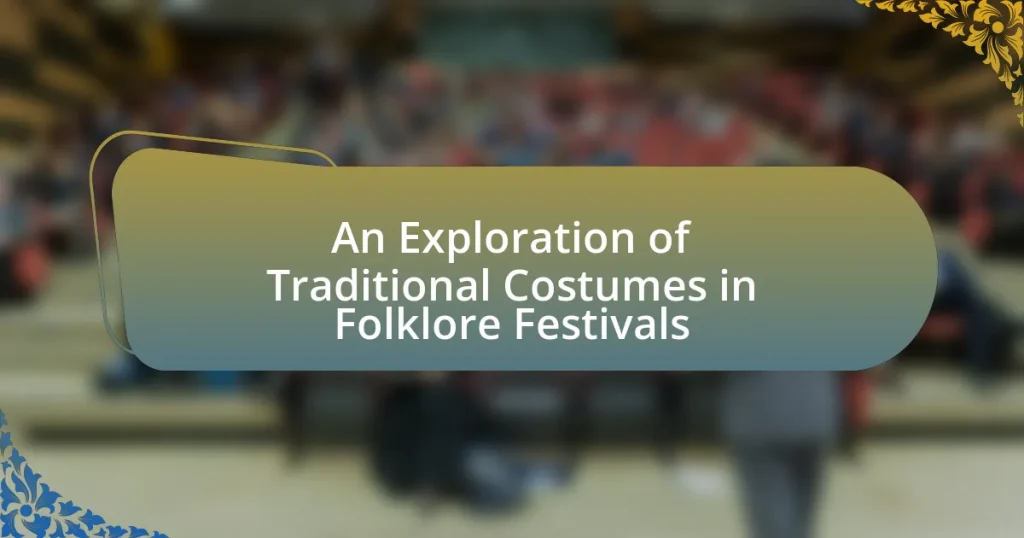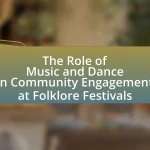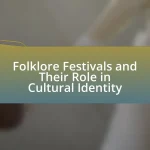Traditional costumes in folklore festivals are garments that embody the cultural heritage, history, and identity of specific communities. These costumes reflect cultural identity through unique designs, colors, and materials, serving as visual representations of traditions and customs. The article explores how these costumes are created, maintained, and evolved over time, highlighting the significance of colors and patterns in conveying cultural meanings. It also examines the role of traditional costumes in storytelling, their importance in enhancing festival experiences, and the variations across different cultures, emphasizing the shared themes of human expression found in traditional attire.
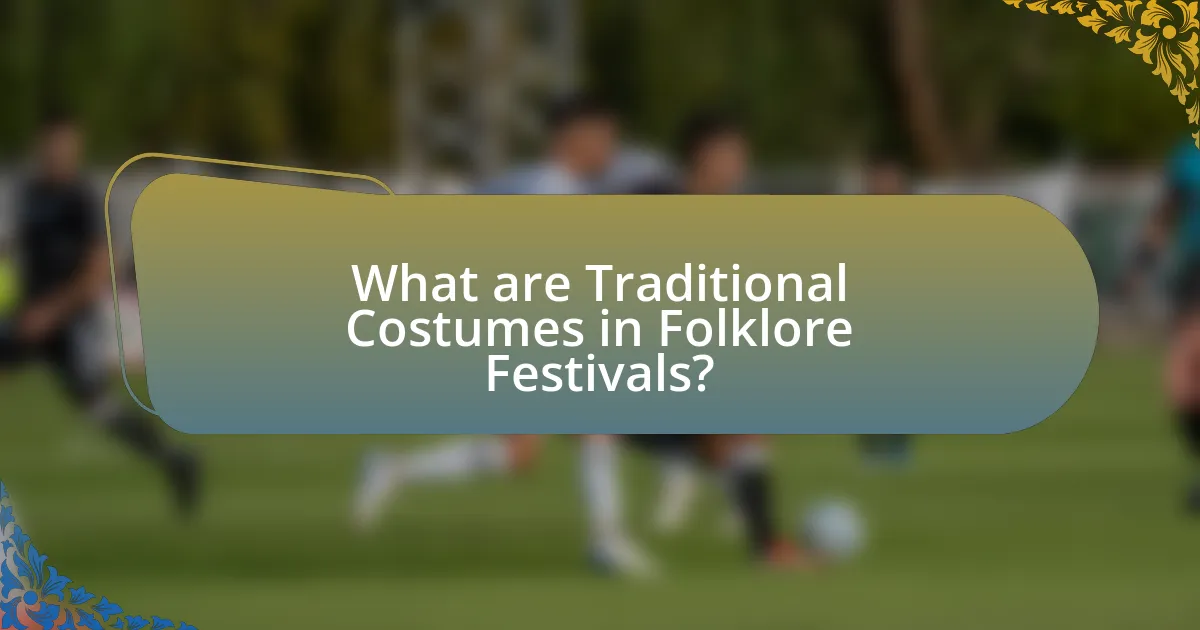
What are Traditional Costumes in Folklore Festivals?
Traditional costumes in folklore festivals are garments that reflect the cultural heritage, history, and identity of a specific community or region. These costumes often incorporate unique designs, colors, and materials that are significant to the traditions and customs of the people, serving as a visual representation of their folklore. For example, in many European countries, traditional costumes may include embroidered dresses, specific patterns, and accessories that denote social status or regional affiliation, showcasing the diversity and richness of cultural expressions during these festivals.
How do traditional costumes reflect cultural identity?
Traditional costumes reflect cultural identity by embodying the values, beliefs, and historical narratives of a community. These garments often incorporate specific colors, patterns, and materials that are significant to a culture, serving as visual representations of heritage. For instance, the use of tartan patterns in Scottish kilts signifies clan affiliation and regional identity, while the intricate embroidery in Mexican huipils showcases indigenous craftsmanship and cultural symbolism. Such costumes are not merely clothing; they are a means of preserving and expressing cultural narratives, as evidenced by their prominent role in folklore festivals where communities celebrate their unique traditions and histories.
What elements contribute to the design of these costumes?
The elements that contribute to the design of traditional costumes in folklore festivals include cultural symbolism, materials used, color schemes, and craftsmanship techniques. Cultural symbolism reflects the heritage and identity of the community, often incorporating motifs and patterns that have historical significance. The materials used, such as fabrics and embellishments, are chosen based on availability and traditional practices, influencing the costume’s durability and aesthetic. Color schemes are often vibrant and meaningful, representing various aspects of the culture, such as nature or social status. Craftsmanship techniques, including weaving, embroidery, and tailoring, are passed down through generations, ensuring authenticity and quality in the costume design. These elements collectively create costumes that are not only visually striking but also rich in cultural narrative and significance.
How do colors and patterns signify different meanings?
Colors and patterns in traditional costumes signify different meanings by conveying cultural identity, social status, and emotional expression. For instance, in many cultures, red symbolizes strength and vitality, while white often represents purity and peace. Patterns, such as stripes or floral designs, can indicate regional origins or specific cultural narratives. In the context of folklore festivals, these visual elements serve as a language that communicates heritage and traditions, allowing participants to express their community’s values and beliefs. Historical examples include the use of specific colors in Native American attire, where each hue has distinct spiritual significance, or the intricate patterns in African textiles that tell stories of ancestry and social roles.
Why are traditional costumes important in folklore festivals?
Traditional costumes are important in folklore festivals because they serve as a visual representation of cultural identity and heritage. These costumes embody the history, traditions, and values of a community, allowing participants to express their cultural narratives. For instance, specific patterns, colors, and styles often reflect regional customs and historical events, reinforcing a sense of belonging and continuity among community members. Additionally, traditional costumes enhance the overall aesthetic and authenticity of folklore festivals, attracting audiences and fostering appreciation for diverse cultural expressions.
What role do they play in storytelling and performance?
Traditional costumes play a crucial role in storytelling and performance by visually representing cultural narratives and historical contexts. These costumes serve as symbols that convey the identity, values, and traditions of a community, enhancing the audience’s understanding of the story being told. For instance, in folklore festivals, specific attire often signifies particular characters or roles, allowing performers to embody their narratives authentically. This visual representation is supported by research indicating that costumes can influence audience perception and emotional engagement, as seen in studies on theatrical performance where costumes significantly affect character interpretation and audience connection.
How do they enhance the overall festival experience?
Traditional costumes enhance the overall festival experience by visually representing cultural heritage and fostering community engagement. These costumes serve as a medium for storytelling, allowing participants and spectators to connect with the history and traditions of the culture being celebrated. For instance, in folklore festivals, the vibrant colors and intricate designs of traditional attire can evoke a sense of pride and belonging among community members, while also attracting tourists and enhancing the festival’s appeal. Studies have shown that festivals featuring traditional costumes can increase attendance by up to 30%, as they create a unique and immersive atmosphere that encourages participation and appreciation of cultural diversity.
What are the historical origins of traditional costumes in folklore festivals?
Traditional costumes in folklore festivals originate from the cultural practices and historical contexts of specific communities, reflecting their identity, heritage, and social customs. These costumes often evolved from everyday clothing worn by ancestors, incorporating elements that signify regional characteristics, historical events, and social status. For instance, in Europe, traditional garments like the Bavarian dirndl or the Scottish kilt have roots in the clothing of rural populations, adapted over centuries to represent local traditions during festivals. The use of vibrant colors, specific patterns, and unique accessories in these costumes serves to celebrate and preserve cultural narratives, as evidenced by the continued popularity of such attire in events like Oktoberfest and Highland Games.
How have these costumes evolved over time?
Traditional costumes in folklore festivals have evolved significantly over time, reflecting changes in cultural identity, societal norms, and artistic expression. Initially, these costumes were primarily functional, designed for everyday use and influenced by local materials and climate. As societies progressed, the costumes began to incorporate more elaborate designs, colors, and embellishments, often symbolizing regional pride and heritage.
For example, in Europe, the transition from simple peasant attire to ornate garments during the Renaissance period showcased increased wealth and artistic influence. By the 19th century, the rise of nationalism led to a revival of traditional costumes, as countries sought to celebrate their unique cultural identities through festivals. This evolution continued into the 20th century, where globalization introduced new materials and styles, blending traditional elements with contemporary fashion trends.
The ongoing adaptation of these costumes is evident in modern folklore festivals, where traditional garments are often reinterpreted to appeal to younger generations while still honoring historical roots. This dynamic evolution illustrates how traditional costumes serve not only as a means of cultural expression but also as a reflection of societal changes over time.
What influences have shaped their development?
Cultural, historical, and social influences have shaped the development of traditional costumes in folklore festivals. Cultural influences include the specific customs and practices of a community, which dictate the colors, patterns, and materials used in costumes. Historical influences stem from significant events or periods that have left a mark on the community’s identity, such as colonialism or migration, leading to the incorporation of diverse elements into traditional attire. Social influences arise from the community’s values and beliefs, which are reflected in the symbolism and functionality of the costumes during festivals. For example, the use of specific motifs may represent local myths or historical narratives, reinforcing the community’s heritage and identity during these celebrations.
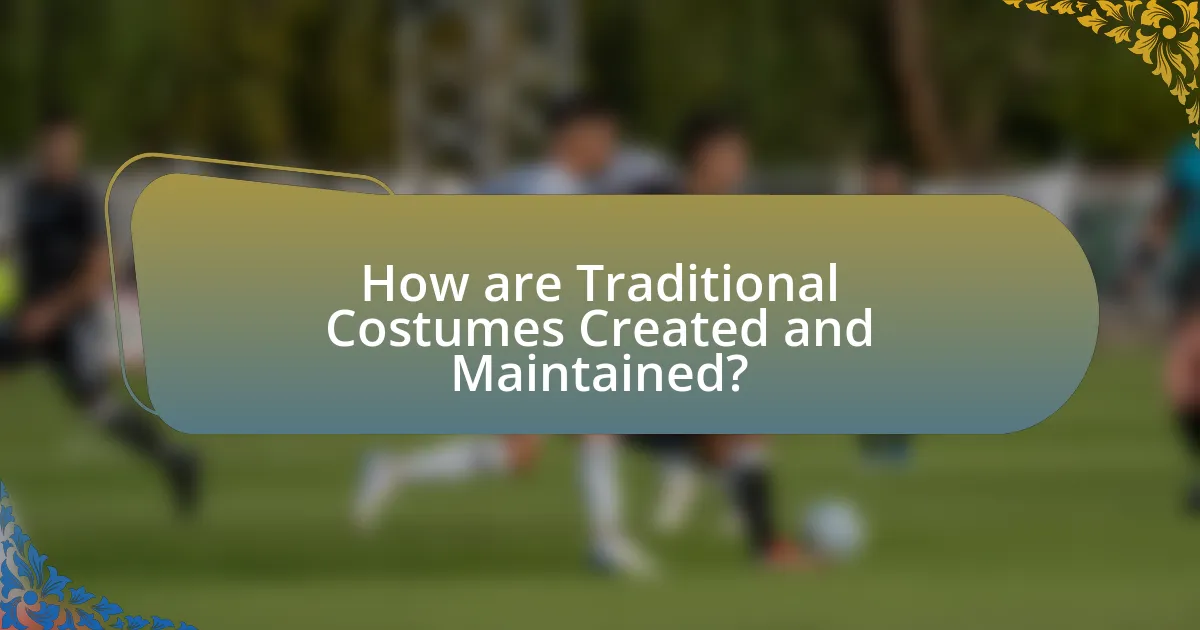
How are Traditional Costumes Created and Maintained?
Traditional costumes are created through a combination of cultural heritage, skilled craftsmanship, and the use of specific materials that reflect the traditions of a community. Artisans often draw on historical designs, local textiles, and techniques passed down through generations to ensure authenticity. For maintenance, these costumes require careful handling, regular cleaning, and sometimes repairs to preserve their condition and cultural significance. For instance, in many cultures, traditional garments are stored in specific ways to prevent damage from light and moisture, ensuring they remain intact for future generations.
What materials are commonly used in making traditional costumes?
Traditional costumes are commonly made from materials such as cotton, silk, wool, and linen. Cotton is favored for its breathability and comfort, making it ideal for warm climates. Silk is often used for its luxurious appearance and drape, particularly in ceremonial attire. Wool provides warmth and durability, suitable for colder regions, while linen is valued for its lightweight and moisture-wicking properties. These materials have been historically utilized in various cultures to reflect social status, regional identity, and cultural heritage, reinforcing their significance in traditional costume-making.
How do local resources influence material choices?
Local resources significantly influence material choices in the creation of traditional costumes for folklore festivals. The availability of specific materials, such as locally sourced fabrics, dyes, and embellishments, directly impacts the design and construction of these costumes. For instance, regions rich in cotton may lead to the use of cotton textiles, while areas with abundant natural dyes will see vibrant colors derived from local plants. This reliance on local resources not only reflects the cultural identity of the community but also promotes sustainability by reducing transportation costs and environmental impact. Historical practices show that traditional costumes often incorporate materials that are readily available, ensuring that the costumes are both practical and representative of the local heritage.
What techniques are employed in the crafting process?
The techniques employed in the crafting process of traditional costumes for folklore festivals include sewing, embroidery, dyeing, and weaving. Sewing is fundamental for assembling fabric pieces into garments, while embroidery adds decorative elements that reflect cultural significance. Dyeing techniques, such as natural dyeing, are used to achieve vibrant colors that are often symbolic. Weaving is essential for creating textiles with specific patterns that represent regional identities. These techniques are rooted in historical practices, with many artisans passing down skills through generations, ensuring the authenticity and cultural relevance of the costumes.
How do communities preserve traditional costume-making skills?
Communities preserve traditional costume-making skills through intergenerational knowledge transfer, workshops, and cultural events. Elders often teach younger generations the techniques and significance of costume-making, ensuring that these skills are not lost. Workshops organized by cultural organizations provide hands-on experience, allowing participants to learn traditional methods and materials. Additionally, folklore festivals serve as platforms for showcasing these costumes, reinforcing their cultural importance and encouraging community participation in their creation. This multifaceted approach helps maintain the relevance and practice of traditional costume-making within the community.
What role do workshops and festivals play in skill transmission?
Workshops and festivals play a crucial role in skill transmission by providing hands-on learning experiences and opportunities for cultural exchange. These events facilitate direct interaction between skilled artisans and participants, allowing for the sharing of techniques, traditions, and knowledge related to traditional costumes. For instance, workshops often include demonstrations and guided practice, enabling attendees to learn specific skills such as sewing, embroidery, or fabric dyeing that are integral to the creation of traditional attire. Festivals, on the other hand, showcase these skills in a communal setting, reinforcing their importance within the culture and encouraging the next generation to engage with and preserve these practices. Research indicates that such immersive experiences significantly enhance retention of skills and cultural heritage, as evidenced by increased participation in traditional crafts following these events.
How can younger generations be encouraged to participate?
Younger generations can be encouraged to participate in folklore festivals by integrating modern technology and social media into the promotion and engagement strategies of these events. Utilizing platforms like Instagram and TikTok can attract younger audiences by showcasing vibrant visuals and interactive content related to traditional costumes and festival activities. Research indicates that 72% of teenagers use social media, making it a powerful tool for outreach (Pew Research Center, 2021). Additionally, offering workshops that allow younger participants to create their own costumes can foster a personal connection to the traditions, enhancing their interest and involvement in the festivals.
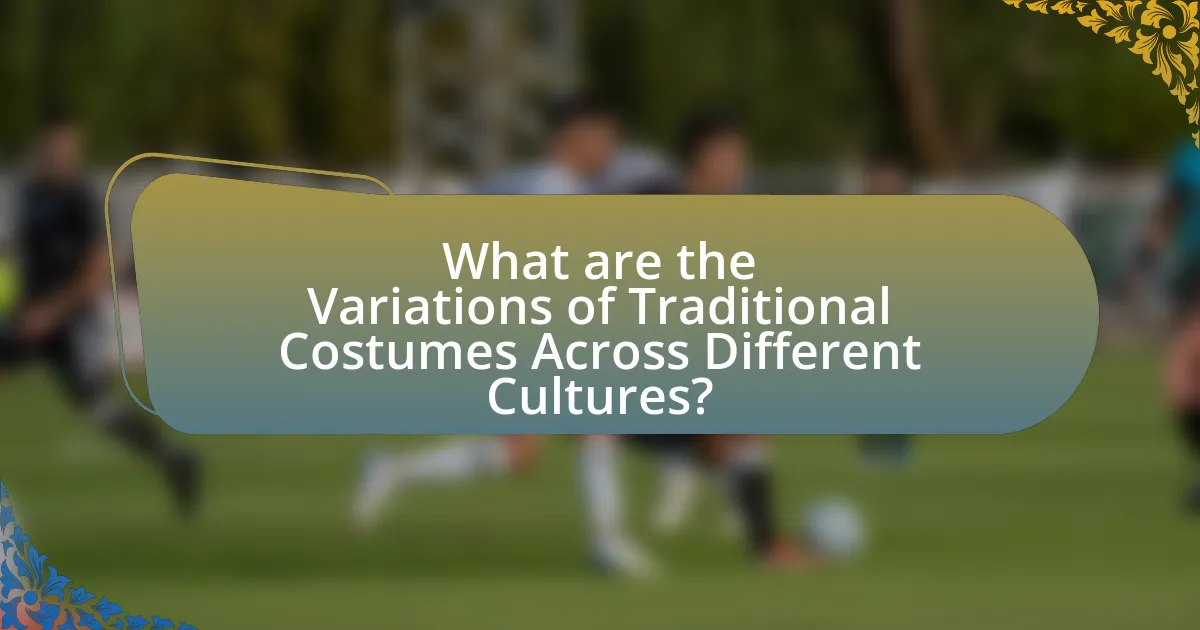
What are the Variations of Traditional Costumes Across Different Cultures?
Variations of traditional costumes across different cultures reflect unique historical, geographical, and social influences. For instance, the kimono in Japan symbolizes elegance and tradition, while the sari in India represents cultural identity and is often worn during festivals. In Scotland, the kilt signifies heritage and is associated with clan identity, whereas the huipil in Mexico showcases indigenous craftsmanship and vibrant colors. Each of these costumes serves not only as clothing but also as a representation of cultural values, beliefs, and artistic expression, illustrating the diversity of human experience across the globe.
How do traditional costumes differ between regions?
Traditional costumes differ between regions primarily due to variations in cultural heritage, climate, and available materials. For instance, in colder regions, traditional costumes often include heavier fabrics and layers, such as wool or fur, while warmer regions favor lighter materials like cotton or linen. Additionally, specific colors, patterns, and embellishments reflect local customs and historical influences; for example, the vibrant colors and intricate embroidery of Mexican traditional dress contrast sharply with the more subdued tones and simpler designs found in Scandinavian folk costumes. These differences are rooted in the unique histories and social practices of each region, showcasing the diversity of cultural expressions through attire.
What are some notable examples of regional variations?
Notable examples of regional variations in traditional costumes during folklore festivals include the vibrant attire of the Bavarian Oktoberfest, characterized by lederhosen for men and dirndls for women, which reflect the cultural heritage of southern Germany. In contrast, the colorful saris worn during the Durga Puja in West Bengal, India, showcase the region’s rich textile traditions and religious significance. Additionally, the elaborate masks and costumes of the Carnival of Venice highlight the unique Venetian history and artistry, while the traditional kilts and tartans of Scotland during Highland Games emphasize the distinct Scottish identity. Each of these examples illustrates how regional cultural elements influence the design and significance of traditional costumes in folklore festivals.
How do local customs influence costume design?
Local customs significantly influence costume design by dictating the materials, colors, patterns, and styles used in traditional attire. For instance, in many cultures, specific colors and patterns are associated with particular festivals or rituals, reflecting local beliefs and values. In Japan, the kimono’s design varies by region, with distinct patterns representing local flora and fauna, showcasing the area’s cultural heritage. Additionally, customs surrounding celebrations, such as the Day of the Dead in Mexico, dictate the use of vibrant colors and symbolic motifs in costumes, emphasizing the connection to ancestral traditions. This interplay between local customs and costume design ensures that attire not only serves a functional purpose but also embodies cultural identity and community values.
What similarities can be found in traditional costumes worldwide?
Traditional costumes worldwide often share similarities in their use of vibrant colors, intricate patterns, and symbolic motifs that reflect cultural heritage. Many cultures utilize bright hues to convey joy and celebration, while patterns often represent local history or nature, such as floral designs in various regions. Additionally, traditional garments frequently incorporate specific materials and techniques unique to the region, yet they may all feature elements like embroidery or weaving that signify craftsmanship and identity. For instance, the use of textiles in traditional costumes can be seen in the kimonos of Japan and the saris of India, both showcasing elaborate designs that tell stories of their respective cultures.
How do shared cultural themes manifest in costume design?
Shared cultural themes manifest in costume design through the incorporation of traditional symbols, colors, and patterns that reflect the values and beliefs of a community. For instance, in folklore festivals, costumes often feature motifs that represent local myths, historical events, or natural elements significant to the culture, such as floral designs in Eastern European attire symbolizing fertility and growth. Additionally, the use of specific colors can convey cultural meanings; for example, red may symbolize luck in Chinese culture, influencing the design choices in costumes worn during celebrations. These elements not only serve aesthetic purposes but also reinforce cultural identity and continuity, as seen in the vibrant costumes of the Carnival in Brazil, which blend indigenous, African, and European influences, showcasing the diverse heritage of the nation.
What can these similarities tell us about human expression?
Similarities in traditional costumes across folklore festivals reveal that human expression is deeply rooted in cultural identity and shared values. These costumes often reflect common themes such as community, heritage, and historical narratives, showcasing how different societies articulate their uniqueness while also connecting with universal human experiences. For instance, the use of vibrant colors and specific motifs in costumes can signify particular cultural stories or beliefs, demonstrating how visual elements serve as a language of expression. This is supported by anthropological studies that highlight the role of attire in conveying social status, group belonging, and cultural continuity, illustrating that traditional costumes are not merely decorative but are integral to the expression of human identity and collective memory.
What are some best practices for appreciating traditional costumes at folklore festivals?
To appreciate traditional costumes at folklore festivals, attendees should engage in respectful observation and active learning. Observing the intricate details, materials, and craftsmanship of the costumes allows for a deeper understanding of cultural significance. Engaging with the wearers by asking questions about their attire fosters a connection and enhances appreciation. Additionally, attending workshops or presentations related to the costumes can provide historical context and cultural narratives, enriching the overall experience. These practices are supported by studies indicating that active participation and respectful inquiry enhance cultural appreciation and understanding at such events.
How can festival-goers respectfully engage with cultural displays?
Festival-goers can respectfully engage with cultural displays by actively learning about the significance of the traditions and costumes being showcased. Understanding the cultural context allows attendees to appreciate the displays more deeply and interact in a manner that honors the heritage represented. For instance, many folklore festivals provide educational materials or workshops that explain the history and meaning behind traditional costumes, which can enhance the experience and foster respectful engagement. Additionally, festival-goers should seek permission before taking photographs or participating in any activities, as this demonstrates respect for the cultural practices and the individuals involved.
What should attendees know before attending a folklore festival?
Attendees should know that traditional costumes play a significant role in folklore festivals, as they represent cultural heritage and identity. Understanding the meaning and significance of these costumes enhances the festival experience, allowing attendees to appreciate the artistry and history behind them. For instance, many costumes are specific to regions or communities, often featuring unique patterns and colors that reflect local traditions. Additionally, attendees should be aware that some festivals encourage participation in traditional attire, which fosters a sense of community and celebration.










